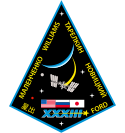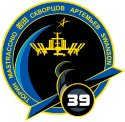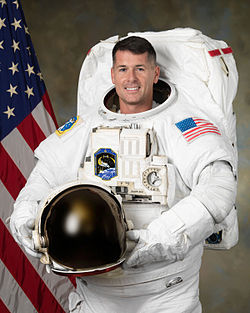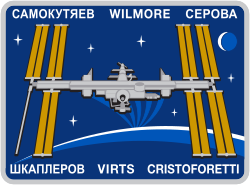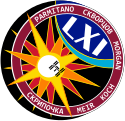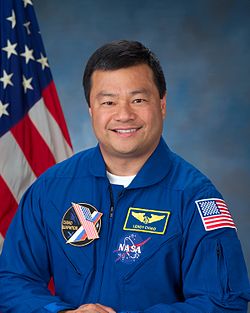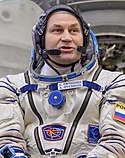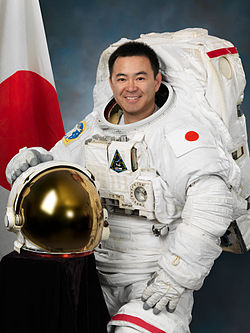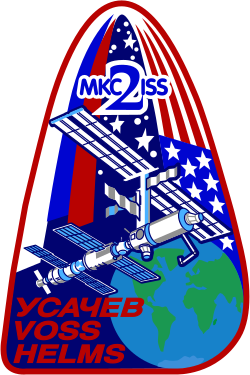Seznam velitelů Mezinárodní vesmírné stanice
Seznam obsahuje v chronologickém pořadí všechny kosmonauty a astronauty, kteří sloužili ve funkci velitele Mezinárodní vesmírné stanice (ISS).
Velitel Mezinárodní vesmírné stanice
Odpovědnost velitele ISS je definována Kodexem chování ISS, který uvádí, že velitel ISS má určitou pravomoc nad provozem stanice, ale většinu rozhodnutí by měl nakonec přenechat letovému řediteli.[1]
Odpovědností velitele ISS je:[1]
- provádět operace v ISS nebo na ní podle pokynů ředitele letu a v souladu s letovými pravidly, plány a postupy,
- řídit činnost členů posádky ISS jako jednoho integrovaného týmu s cílem zajistit úspěšné dokončení mise,
- plně a přesně a včas informovat ředitele letu o konfiguraci vozidla ISS, jeho stavu, velení a dalších provozních činnostech na palubě, včetně situací, které nejsou v normě, nebo nouzových situací,
- prosazovat postupy pro fyzickou a informační bezpečnost provozních a provozních údajů,
- udržovat pořádek,
- zajišťovat bezpečnost, zdraví a pohodu posádky, včetně její záchrany a návratu,
- podnikat veškerá přiměřená opatření nezbytná k ochraně prvků, vybavení nebo užitečného zatížení ISS.
Předání funkce velitele ISS
Předem určený člen posádky stanice přebírá velení od svého předchůdce v krátkém neformálním ceremoniálu, který se obvykle odehrává několik hodin před odletem dosavadního velitele ze stanice.
Velitel má u sebe po dobu výkonu funkce symbolický klíč od stanice, kterým je kopie kliky používané k otevírání poklopů vedoucích do ruského segmentu stanice. Převzetím symbolického klíče se nový velitel ujímá své funkce.[2]
Statistika
ISS měla za dobu své existence dosud celkem 57 velitelů, z nichž pouze 10 lidí tuto funkci vykonávalo opakovaně:
- Gennadij Padalka 4krát,
- Fjodor Jurčichin a Oleg Kononěnko 3krát,
- Akihiko Hošide, Scott Kelly, Oleg Kotov, Anton Škaplerov, Pavel Vinogradov, Peggy Whitsonová a Jeffrey Williams 2krát.
Ze 71 funkčních období velitele připadlo:
Nejdelší výkon funkce velitele – 350 dní – připadl mezi říjnem 2022 a zářím 2023 Sergeji Prokopjevovi. Nejkratší dobu ve funkci velitelky – 11 dní – si v dubnu 2021 připsala Shannon Walkerová.
Seznam velitelů ISS
| # | Převzetí funkce | Velitel ISS | Portrét | Probíhající expedice | Znak | Pozn. |
|---|---|---|---|---|---|---|
| 1 | 2. listopadu 2000[3][4] |  | Expedice 1 |  | První velitel ISS a současně první Američan v této funkci. | |
| 2 | 19. března 2001[5] |  | Expedice 2 |  | První ruský velitel ISS. | |
| 3 | 18. srpna 2001[6] |  | Expedice 3 |  | Jediný Američan na palubě ISS v okamžiku teroristických útoků na USA 11. září 2001.[7] | |
| 4 | 13. prosince 2001[8] |  | Expedice 4 |  | ||
| 5 | 10. června 2002[9] |  | Expedice 5 |  | ||
| 6 | 30. listopadu 2002[10] |  | Expedice 6 |  | ||
| 7 | 3. května 2003[11]; |  | Expedice 7 |  | První člověk, který se ve vesmíru oženil.[12] | |
| 8 | 27. října 2003[13] |  | Expedice 8 |  | ||
| 9 | 26. dubna 2004[14] |  | Expedice 9 |  | ||
| 10 | 22. října 2004[15] |  | Expedice 10 |  | První asijsko-americký velitel ISS. | |
| 11 | 24. dubna 2005[16] | 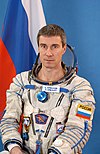 | Expedice 11 |  | ||
| 12 | 10. října 2005[17] |  | Expedice 12 |  | ||
| 13 | 7. dubna 2006[18] |  | Expedice 13 |  | ||
| 14 | 27. září 2006[19] |  | Expedice 14 |  | ||
| 15 | 17. dubna 2007[20] |  | Expedice 15 |  | ||
| 16 | 19. října 2007[21] |  | Expedice 16 |  | První žena velitelkou ISS.[22] | |
| 17 | 17. dubna 2008[23] |  | Expedice 17 |  | Nejmladší velitel ISS (35 let). | |
| 18 | 22. října 2008[24] |  | Expedice 18 |  | ||
| 19 | 2. dubna 2009[25] |  | Expedice 19 / / Expedice 20 |   | Podruhé velitelem ISS, a to na celé dvě expedice (celkem 190 dní). | |
| 20 | 9. října 2009[26] |  | Expedice 21 |  | První neamerický a neruský velitel ISS, první astronaut ESA a první Belgičan v této funkci. | |
| 21 | 1. prosince 2009[27] |  | Expedice 22 |  | ||
| 22 | 17. března 2010[28] |  | Expedice 23 | |||
| 23 | 2. června 2010[29] |  | Expedice 24 |  | ||
| 24 | 22. září 2010[30] |  | Expedice 25 |  | ||
| 25 | 24. listopadu 2010[31] |  | Expedice 26 |  | ||
| 26 | 13. března 2011[32] |  | Expedice 27 |  | ||
| 27 | 22. května 2011[33] |  | Expedice 28 |  | ||
| 28 | 14. září 2011[34] |  | Expedice 29 |  | ||
| 29 | 20. listopadu 2011[35] |  | Expedice 30 |  | ||
| 30 | 25. dubna 2012[36] |  | Expedice 31 |  | ||
| 31 | 29. června 2012[37] |  | Expedice 32 |  | Potřetí velitelem ISS: | |
| 32 | 15. září 2012[38] |  | Expedice 33 |  | ||
| 33 | 17. listopadu 2012[39] |  | Expedice 34 |  | ||
| 34 | 13. března 2013[40] |  | Expedice 35 |  | První Kanaďan velitelem ISS.[40] | |
| 35 | 13. května 2013[41] |  | Expedice 36 |  | Podruhé velitelem ISS. | |
| 36 | 9. září 2013[42] |  | Expedice 37 |  | Podruhé velitelem ISS. | |
| 37 | 10. listopadu 2013[43] |  | Expedice 38 |  | Podruhé velitelem ISS. | |
| 38 | 9. března 2014[44] |  | Expedice 39 |  | První japonský velitel ISS.[44] | |
| 39 | 12. května 2014[45] |  | Expedice 40 |  | ||
| 40 | 9. září 2014[46] | 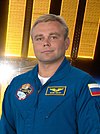 | Expedice 41 |  | ||
| 41 | 10. listopadu 2014[47] | 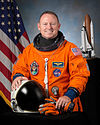 | Expedice 42 |  | ||
| 42 | 10. března 2015[48] |  | Expedice 43 |  | ||
| 43 | 10. června 2015[49] |  | Expedice 44 |  | Počtvrté velitelem ISS. Letem vytvořil rekord v celkové době strávené ve vesmíru (878 dní). | |
| 44 | 5. září 2015[50] |  | Expedice 45 / / Expedice 46 |   | Podruhé velitelem ISS, a to během dvou expedic (celkem 177 dní) | |
| 45 | 29. února 2016[51] |  | Expedice 47 |  | ||
| 46 | 17. června 2016[52] |  | Expedice 48 |  | Podruhé velitelem ISS. | |
| 47 | 5. září 2016[53] |  | Expedice 49 |  | ||
| 48 | 28. října 2016[54] | 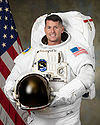 | Expedice 50 |  | ||
| 49 | 9. dubna 2017[55] |  | Expedice 51 |  | Podruhé velitelem ISS. | |
| 50 | 1. června 2017[56] |  | Expedice 52 |  | Potřetí velitelem ISS. | |
| 51 | 1. září 2017[57] |  | Expedice 53 |  | ||
| 52 | 13. prosince 2017[58] |  | Expedice 54 |  | ||
| 53 | 26. února 2018[59] |  | Expedice 55 |  | ||
| 54 | 1. června 2018[60] |  | Expedice 56 |  | ||
| 55 | 4. října 2018[61] |  | Expedice 57 |  | První německý a současně druhý nejmladší velitel ISS (42 let). | |
| 56 | 18. prosince 2018[62] |  | Expedice 58 / / Expedice 59 |   | Podruhé velitelem ISS, a to na dvě expedice (celkem 188) dní. | |
| 57 | 24. června 2019[63] |  | Expedice 60 |  | ||
| 58 | 2. října 2019[64] |  | Expedice 61 |  | První italský velitel ISS. | |
| 59 | 6. února 2020[65] |  | Expedice 62 |  | ||
| 60 | 15. dubna 2020[66] |  | Expedice 63 |  | ||
| 61 | 21. října 2020[67][68][69] | 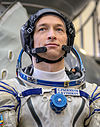 | Expedice 64 |  | ||
| 62 | 15. dubna 2021[70] |  | Expedice 65 |  | Nejkratší doba ve funkci velitele nebo velitelky ISS (11 dní). | |
| 63 | 27. dubna 2021[71] |  | Expedice 65 |  | Druhý japonský velitel ISS. | |
| 64 | 4. října 2021[72] |  | Expedice 65 / / Expedice 66 |   | První Francouz velitelem ISS. | |
| 65 | 6. listopadu 2021[73] |  | Expedice 66 |  | Podruhé velitelem ISS. | |
| 66 | 29. března 2022[74][75] |  | Expedice 67 |  | ||
| 67 | 4. května 2022[76] |  | Expedice 67 |  | ||
| 68 | 28. září 2022[77] |  | Expedice 68 |  | První Evropanka velitelkou ISS. | |
| 69 | 12. října 2022[78] |  | Expedice 68 / / Expedice 69 |   | Velitelem po celé 2 expedice (celkem 350 dní) | |
| 70 | 26. září 2023[79] |  | Expedice 70 |  | První dánský velitel ISS. | |
| 71 | 10. března 2024[80] |  | Expedice 71 |  | Potřetí velitelem ISS. | |
| 72 | 22. září 2024[81][82] |  | Expedice 72 |  | Podruhé velitelkou ISS. | |
| 73 | 7. března 2025[83][84] |  | Expedice 72 |  | Podruhé velitelem ISS | |
| Budoucí velitelé | ||||||
Odkazy
Reference
V tomto článku byl použit překlad textu z článku List of commanders of the International Space Station na anglické Wikipedii.
- ↑ a b www.govinfo.gov [online]. [cit. 2023-09-19]. Dostupné online.
- ↑ Anton Škaplerov na Twitteru. X (formerly Twitter) [online]. [cit. 2023-09-19]. Dostupné online.
- ↑ International Space Hall of Fame :: New Mexico Museum of Space History :: Inductee Profile [online]. [cit. 2020-04-15]. Dostupné v archivu pořízeném z originálu dne 2019-04-10.
- ↑ UNSA-Notable Graduates [online]. Dostupné online.
- ↑ Celebrating 30 Years of the space shuttle program. [s.l.]: U.S. National Aeronautics and Space Administration; annotated edition (June 15, 2012), 2012. ISBN 978-0-16-090202-4. S. 213.
- ↑ Space Station Has a New Commander - 2001-08-18 | Voice of America - English [online]. [cit. 2020-04-15]. Dostupné online. (anglicky)
- ↑ SMITH, Yvette. NASA Remembers September 11th [online]. 2015-08-25 [cit. 2020-04-15]. Dostupné online. (anglicky)
- ↑ Volume 2 Space Shuttle Mission Chronology: 2000-2003 [online]. 2005. Dostupné online.
- ↑ Spaceflight Now | STS-111 | Command of space station handed to new crew [online]. [cit. 2020-04-16]. Dostupné online.
- ↑ U.S. Astronaut Takes Over at Space Station [online]. 2002-11-30 [cit. 2020-04-16]. Dostupné online. (anglicky)
- ↑ International Space Station Status Report #03-21 [online]. [cit. 2020-04-16]. Dostupné v archivu pořízeném z originálu dne 2003-07-14.
- ↑ BAKER, Sinéad. The story of the first ever space wedding, when a woman on Earth married a cardboard cutout of her astronaut boyfriend while he watched on from the International Space Station [online]. [cit. 2020-04-16]. Dostupné online.
- ↑ International Space Station Status Report #03-56 [online]. [cit. 2020-04-16]. Dostupné v archivu pořízeném z originálu dne 2004-11-17.
- ↑ Photo-iss008e22320 [online]. [cit. 2020-04-16]. Dostupné v archivu pořízeném z originálu dne 2004-11-09.
- ↑ NASA Space Station On-Orbit Status 20 October 2004 [online]. [cit. 2020-04-16]. Dostupné online.
- ↑ NASA Space Station On-Orbit Status 24 April 2005 [online]. [cit. 2020-04-16]. Dostupné online.
- ↑ Russian-U.S. crew, space tourist return to Earth | The Star Online [online]. [cit. 2020-04-16]. Dostupné online.
- ↑ APRIL 2006, Tariq Malik 08. Mission's End: ISS Astronauts to Return to Earth [online]. 8 April 2006 [cit. 2020-04-16]. Dostupné online. (anglicky)
- ↑ Expedition 14 takes over ISS command [online]. [cit. 2020-04-16]. Dostupné online. (anglicky)
- ↑ New crew assumes space station duties [online]. [cit. 2020-04-16]. Dostupné online. (anglicky)
- ↑ YVETTE. NASA - First Woman Station Commander Arrives for Historic Spaceflight [online]. [cit. 2020-04-16]. Dostupné online. (anglicky)
- ↑ APRIL 2017, Hanneke Weitering 05. NASA's Record-Breaking Astronaut Peggy Whitson Gets 3 Extra Months in Space [online]. 5 April 2017 [cit. 2020-04-16]. Dostupné online. (anglicky)
- ↑ Photo-iss016e036373 [online]. [cit. 2020-04-16]. Dostupné v archivu pořízeném z originálu dne 2008-04-26.
- ↑ NASA - Expedition 17 and Expedition 18 Crews [online]. [cit. 2020-04-16]. Dostupné online. (anglicky)
- ↑ NASA ISS On-Orbit Status 2 April 2009 [online]. [cit. 2020-04-16]. Dostupné online.
- ↑ ESA ISS Science & System - Operations Status Report Increment 20 9 October 2009 [online]. [cit. 2020-04-16]. Dostupné online.
- ↑ Expedition 21 and 22 Assembling Science [online]. September 2009. Dostupné online.
- ↑ NASA. NASA TV Provides Coverage of One Space Station Crew's Return to Earth and Another's Journey There [online]. [cit. 2020-04-16]. Dostupné online. (anglicky)
- ↑ Change of Command on ISS. [s.l.]: [s.n.] Dostupné online.
- ↑ NASA TV To Provide Coverage Of Next Soyuz Landing, Launch. www.nasa.gov. September 2010. Dostupné online.
- ↑ ESA ISS Science & System - Operations Status Report # 82, Increment 25/26 [online]. [cit. 2020-04-16]. Dostupné online. (anglicky)
- ↑ ESA ISS Science & System - Operations Status Report # 90, Increment 26/27 [online]. [cit. 2020-04-16]. Dostupné online. (anglicky)
- ↑ ESA ISS Science & System - Operations Status Report # 95, Increment 27/28 [online]. [cit. 2020-04-16]. Dostupné online. (anglicky)
- ↑ ADMINISTRATOR, NASA Content. NASA TV Will Broadcast Soyuz Landing On Sept. 15 [online]. 2015-04-07 [cit. 2020-04-16]. Dostupné online. (anglicky)
- ↑ YVETTE. New Space Station Crew Members Launch from Kazakhstan [online]. 2015-04-07 [cit. 2020-04-16]. Dostupné online. (anglicky)
- ↑ ESA ISS Science & System - Operations Status Report # 118 Increment 30/31 [online]. [cit. 2020-04-16]. Dostupné online. (anglicky)
- ↑ ISS Command Changes Hands. [s.l.]: [s.n.] Dostupné online.
- ↑ SEPTEMBER 2012, Tariq Malik 15. Record-Setting Female Astronaut Takes Command of Space Station [online]. 15 September 2012 [cit. 2020-04-16]. Dostupné online. (anglicky)
- ↑ ESA ISS Science & System - Operations Status Report # 133 Increment 33/34 : 17–30 November [online]. [cit. 2020-04-16]. Dostupné online. (anglicky)
- ↑ a b MARCH 2013, Robert Z. Pearlman 14. Canada in Charge: Astronaut Becomes 1st Canadian Space Station Commander [online]. 14 March 2013 [cit. 2020-04-16]. Dostupné online. (anglicky)
- ↑ ADMINISTRATOR, NASA Content. Expedition 35/36 Crews Place Logos [online]. 2015-03-29 [cit. 2020-04-16]. Dostupné online.
- ↑ GARCIA, Mark. Expedition 36 Crew Members [online]. 2015-03-29 [cit. 2020-04-16]. Dostupné online.
- ↑ ESA ISS Science & System - Operations Status Report # 157 Increment 37/38: 2 – 15 November 2013. www.esa.int [online]. [cit. 2023-09-20]. Dostupné online. (anglicky)
- ↑ a b MARCH 2014, Robert Z. Pearlman 10. Kibo Commander: Koichi Wakata Becomes 1st Japanese to Command Space Station [online]. 10 March 2014 [cit. 2020-04-16]. Dostupné online. (anglicky)
- ↑ NASA TV to Air Expedition 39's Return From ISS Today! [online]. 2014-05-13 [cit. 2020-04-16]. Dostupné online. (anglicky)
- ↑ NORTHON, Karen. NASA Television to Broadcast Sept. 10 Return of Space Station Crew [online]. 2015-04-07 [cit. 2020-04-16]. Dostupné online.
- ↑ Tennessee astronaut assumes command of space station [online]. [cit. 2020-04-16]. Dostupné online.
- ↑ WILLIAMS, Robert. ISS Expedition 42/43 Change of Command Ceremony (Wilmore hands over ISS Command to Virts) [online]. 2015-02-05 [cit. 2020-04-16]. Dostupné online.
- ↑ WILLIAMS, Robert. ISS Expedition 43/44 Change of Command Ceremony (Virts hands over ISS Command to Padalka) (Starts at 10:40 a.m.) [online]. 2015-06-05 [cit. 2020-04-16]. Dostupné online.
- ↑ WILLIAMS, Robert. ISS Expedition 44/45 Change of Command Ceremony (Padalka hands over ISS Command to Kelly) (starts at 2:40 p.m.) [online]. 2015-07-31 [cit. 2020-04-16]. Dostupné online.
- ↑ WILLIAMS, Robert. ISS Expedition 46/47 Change of Command Ceremony (Kelly hands over ISS command to Kopra) (starts at 3:10 p.m.) [online]. 2016-01-27 [cit. 2020-04-16]. Dostupné online.
- ↑ Astronauts Swap Station Command Friday Morning – Space Station [online]. [cit. 2020-04-16]. Dostupné online. (anglicky)
- ↑ Expedition 48 Trio Enters Soyuz and Closes Hatches – Space Station [online]. [cit. 2020-04-16]. Dostupné v archivu pořízeném z originálu dne 2022-05-21. (anglicky)
- ↑ CHESTNUT, Charles. ISS Expedition 49-50 Change of Command Ceremony (Ivanishin hands over ISS command to Kimbrough) [online]. 2016-10-27 [cit. 2020-04-16]. Dostupné online.
- ↑ WILLIAMS, Robert. ISS Expedition 50/51 Change of Command Ceremony (Kimbrough hands over ISS Command to Whitson) (Starts at 10:40a.m.) [online]. 2017-03-14 [cit. 2020-04-16]. Dostupné online.
- ↑ Expedition 51 – Space Station [online]. [cit. 2020-04-16]. Dostupné online. (anglicky)
- ↑ Change of command ceremony expedition 52-53 [online]. 2017-09-02. Dostupné online.
- ↑ CHESTNUT, Charles. ISS Expedition 53/54 Change of Command Ceremony (Bresnik hands over ISS command to Misurkin) (Starts at 7:35 a.m.) [online]. 2017-11-16 [cit. 2020-04-15]. Dostupné online.
- ↑ MARCH 2018, Christine Lunsford 04. Space Station Photos: Expedition 55 Crew in Orbit [online]. 4 March 2018 [cit. 2020-04-15]. Dostupné online. (anglicky)
- ↑ HARWOOD, William. One station crew heads home, another preps for launch – Spaceflight Now [online]. [cit. 2020-04-15]. Dostupné online. (anglicky)
- ↑ International Space Station Expedition 56 Crew Returns to Earth, Lands Safely in Kazakhstan | [online]. [cit. 2020-04-15]. Dostupné online.
- ↑ HU, Jane C. Watch the ISS's Expedition 57 crew head back to Earth [online]. [cit. 2020-04-15]. Dostupné online. (anglicky)
- ↑ Expedition 59 – Space Station [online]. [cit. 2020-04-15]. Dostupné online. (anglicky)
- ↑ Station Swaps Commanders Before Crew Departure and Spacewalks – Space Station [online]. [cit. 2020-04-15]. Dostupné v archivu pořízeném z originálu dne 2019-10-03. (anglicky)
- ↑ FEBRUARY 2020, Hanneke Weitering 05. Three astronauts will return to Earth Thursday. You can watch their landing live. [online]. 5 February 2020 [cit. 2020-04-15]. Dostupné online. (anglicky)
- ↑ APRIL 2020, Space com Staff 16. Watch live tonight! 3 space station crewmembers return to Earth [online]. [cit. 2020-04-16]. Dostupné online. (anglicky)
- ↑ Šablona:Cite tweet
- ↑ Flight crew assignments [online]. Dostupné online.
- ↑ Роскосмос подтвердил подписание контракта на доставку астронавта NASA на корабле "Союз" [online]. Dostupné online.
- ↑ Expedition 64 Change of Command - April 15, 2021. [s.l.]: [s.n.] Dostupné online.
- ↑ JAXA星出彰彦宇宙飛行士の国際宇宙ステーション(ISS)長期滞在 搭乗機決定について [online]. July 28, 2020 [cit. 2020-09-07]. Dostupné online. (japonsky)
- ↑ YORK, Joanna. French astronaut next International Space Station commander [online]. 2021-03-19 [cit. 2021-04-21]. Dostupné online.
- ↑ - YouTube. www.youtube.com [online]. [cit. 2023-09-20]. Dostupné online.
- ↑ NASA assigns astronauts for third SpaceX commercial crew mission [online]. SpaceNews, 14 December 2020 [cit. 2021-11-12]. Dostupné online.
- ↑ NASA to Provide Live Coverage of Record-Setting US Astronaut Return [online]. 24 March 2022. Dostupné online.
- ↑ LAVELLE, Author Heidi. The Station Changes Command as Crew-3 Prepares to Depart. blogs.nasa.gov [online]. 2022-05-04 [cit. 2023-09-20]. Dostupné online. (anglicky)
- ↑ Commanding role for ESA astronaut Samantha Cristoforetti [online]. ESA, 28 May 2021 [cit. 2021-11-12]. Dostupné online.
- ↑ UPDATED, Elizabeth Howell last. Europe's 1st female space station commander says 'space ninja' crew is ready to come home. Space.com [online]. 2022-10-12 [cit. 2023-09-20]. Dostupné online. (anglicky)
- ↑ Andreas Mogensen becomes the new ISS commander. [s.l.]: [s.n.] Dostupné online.
- ↑ Expedition 70NASA’s SpaceX Crew-7 Farewell Remarks, Station Change of Command March 10, 2024. [s.l.]: [s.n.] Dostupné online.
- ↑ International Space Station. Roscosmos cosmonaut Oleg Kononenko hands over station command to NASA astronaut Suni Williams at 10:15am ET on Sunday.. X.com [online]. 2024-09-21 [cit. 2024-09-22]. Dostupné online.
- ↑ THE LAUNCH PAD. LIVE! ISS Change Of Command Ceremony. [s.l.]: [s.n.] Dostupné online.
- ↑ International Space Station. NASA astronaut Suni Williams hands over command of the orbital outpost to Roscosmos cosmonaut Alexey Ovchinin at 1:55pm ET today.. x.com [online]. 2025-03-07 [cit. 2025-03-10]. Dostupné online.
- ↑ Station Swaps Commanders and Keeps Up Research Before Crew Swap - NASA [online]. 2025-03-07 [cit. 2025-03-10]. Dostupné online. (anglicky)
Související články
Média použitá na této stránce
This is the national flag of Belgium, according to the Official Guide to Belgian Protocol. It has a 13:15 aspect ratio, though it is rarely seen in this ratio.
Its colours are defined as Pantone black, Pantone yellow 115, and Pantone red 032; also given as CMYK 0,0,0,100; 0,8.5,79,0; and 0,94,87,0.Flag of Canada introduced in 1965, using Pantone colors. This design replaced the Canadian Red Ensign design.
Mission insignia for International Space Station (ISS) Expedition 72
- The official insignia of the Expedition 72 crew that will live and work aboard the International Space Station for a six-month space research mission beginning in late 2024. The simple patch design highlights the configuration of the orbital laboratory with its six roll-out solar arrays augmenting the station's power generation system.
This patch commemorates the sixteenth expeditionary mission to the International Space Station (ISS). The design represents the conjunction of two unique astronomical events: a transit of the ISS across the surface of a full moon, and a nearly complete annular eclipse of the sun. The ISS is shown in its complete configuration, symbolizing the role of this expedition in preparing for the arrival and commissioning of international partner modules and components. The ISS transit across the moon highlights its role in developing the techniques and innovations critical to enable long-duration expeditions to the lunar surface and beyond.
The official mission insignia for International Space Station (ISS) Expedition 66, designed to resemble US highway route 66
- The Expedition 66 patch celebrates the continued utilization of the International Space Station as a path for human and scientific space exploration.
- Its shape reflects the Route 66 highway sign, which once guided an earlier expansion into distant, remote lands. The arc of the Earth’s atmosphere is reminiscent of the well-known stop-motion photos taken by astronauts and cosmonauts of the Earth in eclipse.
- Two future destinations are depicted, the Moon resting inside one of the numerals, and Mars to the right. A multicolored bridge containing the colors of each of this mission’s international partner’s flags (Russia, Germany, France, Japan, and the United States) draws the viewer from the perimeter of the patch into the numeral 66 just as the space station bridges the gap from low-Earth orbit to these distant exploration destinations.
The Expedition 59 crew insignia
- The Expedition 59 patch celebrates the International Space Station’s role as a microgravity science laboratory. The crew, made up of scientists, doctors, engineers and pilots, will conduct hundreds of experiments for the benefit of mankind and our fragile environment on planet Earth.
- The patch shape depicts the cupola windows. Through these windows, astronauts have made many significant observations of Earth’s ecosystems and they have discovered and documented real-time events like volcanic eruptions and earthquakes.
- The position of the Earth at the top of the patch depicts where the Earth would be seen by an astronaut from the cupola. It represents the explorers’ unique perspective on his or her home. The image at the center of the patch is the station itself, the largest single structure humans have ever put into space, an engineering marvel.
- The station is overlaid on an atom, the basic building block of all matter. The atom has three electron orbits with the flags of Russia, the United States of America and Canada, representing the home countries of the Expedition 59 crew. Like electrons in an atom, international cooperation is the basic stabilizing force that enables large scale space exploration.
- To achieve great deeds, humans from all across the globe must work together in peace with a shared vision. The Expedition 59 patch celebrates the massive scientific accomplishments of the space station while highlighting the importance of global teamwork in understanding our planet and continuing with bold exploration in the future.
Cosmonaut Yuri I. Onufrienko of Rosaviakosmos will serve as commander of Expedition Four at the end of 2001 and the first part of 2002.
The Expedition 54 crew insignia
- Orbiting Earth continuously since 1998, the International Space Station (ISS) is one of our greatest engineering achievements. It is depicted in gold, symbolic of constancy and excellence. Flying toward a sunrise represents the station’s contributions to a bright future. That sunrise uses blue, white, and red, the combined national colors of Japan, Russia, and the United States, symbolizing the crew’s cohesiveness. Crewmember names are in blue, symbolizing devotion and loyalty.
- The gold border represents the constant human presence in space onboard the orbiting laboratory. Symbolic of new Russian and U.S. spacecraft that will advance human exploration, the patch is shaped as a capsule. The number 54 is drawn as a path eventually leading to Mars.
- Finally, the stars symbolize the values of leadership, trust, teamwork, and excellence lived by mission control teams throughout the history of human space programs, as well as the global vigilance of those teams while operating the station.
The focal point of the Expedition XXIII emblem illustrates the beautiful planet Earth in the black expanse of space. The International Space Station (ISS) is shown traveling in its orbit around Earth. The ISS orbital path flies through the XXIII to show that this increment is building upon the missions that have gone on before and laying the groundwork for future missions. This illustrates the work being performed aboard the orbiting complex that will lead the way to eventual missions to the moon, Mars and beyond. The mission designation uses Roman numerals to illustrate the home nations of the crew, which are also represented by their national flags. The two stars represent the two teams that make up this expedition crew.
JSC2007-E-08803 Astronaut Douglas H. Wheelock, mission specialist
The Expedition 41 crew members have released their patch and have written some text to go along with it:
- "Portraying the road of human exploration into our vastly unknown universe, all elements of the Expedition 41 patch build from the foundation, our Earth, to the stars beyond our solar system. The focus of our six-month expedition to the International Space Station (ISS) is Earth and its inhabitants as well as a scientific look out into our universe. The distinguishing ISS solar arrays reach onward and serve as the central element, with the icon of an atom underneath representing the multitude of research onboard that will bring new discoveries for the benefit of humanity. The sun is rising over Earth's horizon, spreading its light along the road of human exploration. Equipped with the knowledge and inspiration gained from ISS, our successful multinational cooperation will lead human space exploration to the moon, Mars, and ultimately, the stars. We are Expedition 41. Join us for the adventure."
Following the March 19 Expedition 36/37 (Soyuz 35) press conference, Russian cosmonaut Fyodor Yurchikhin and his two crewmates posed for individual as well as group pictures.
Japan Aerospace Exploration Agency (JAXA) astronaut Koichi Wakata, flight engineer
The mission patch design for the 25th Expedition to the International Space Station (ISS) pays tribute to the rich history of innovation and bold engineering in the quest for knowledge, exploration and discovery in space. The patch highlights the symbolic passing of the torch to the ISS, as the vehicle that will carry us into the future of space exploration. The Space Shuttle Program emblem is the foundation of the patch and forms the Greek letter 'Alpha' with a new dawn breaking at the center, symbolizing a new vision for space exploration. The Alpha symbol is overlaid by the Greek letter 'Omega', paying tribute to the culmination of the Space Shuttle Program. The mission designation '25' is shown centered at the bottom of the patch, symbolizing the point in time when the Space Shuttle, the workhorse of the ISS assembly process, will make its final visit to the ISS. Between the '25' and the Earth crescent, the orbiter is shown returning to Earth on its final journey, during the Expedition 25 mission. Above Earth and the breaking dawn, the ISS takes center-stage, completed and fully equipped to carry us beyond this new dawn to new voyages and discoveries. The orbit connecting the ISS and the Earth is drawn in the colors of the United States and Russian flags; paying tribute to the blended heritage of the crew. The two largest stars in the field represent the arrival and departure of the crews in separate Russian Soyuz vehicles. The six stars in the field represent the six crew members. The International Space Station abbreviation 'ISS' and 'MKC' - in English and Russian, respectively - flank the mission number designation, and the names of the crew members in their native languages border the ISS symbol.
Russian cosmonaut Dmitri Kondratyev, Expedition 26 flight engineer and Expedition 27 commander, poses for a portrait following an Expedition 26/27 preflight press conference at NASA's Johnson Space Center. Kondratyev is scheduled to launch to the International Space Station aboard a Russian Soyuz spacecraft in December 2010.
The crew members of the Expedition 34 mission put together the following description of their patch: "The outer border of the Expedition 34 patch takes the mold line of a crew transfer or generic resupply vehicle which will form our bridge to the orbiting outpost throughout the second half of its operational lifetime. Inscribed inside in gold is a craft symbolizing future extra-terrestrial landers that will someday open other celestial destinations to human exploration. Our Sun, which enables the miracle of the only known life in our universe, radiates above the rich and colorful orb of Earth. Its 15 rays represent the countries of the International Space Station (ISS) Partnership whose foresight and sacrifice have enabled the first small steps into our universe. The ISS in flight represents the dedication, ingenuity, and cooperation amongst the thousands and thousands of workers around the globe who have successfully designed and built a wonder of our modern world. The distant stars, like those visible in our night sky, beckon us to come further into the depths of space. 'Off the Earth. . . For the Earth' - Our acknowledgement of the responsibility and commitment to work diligently for all inhabitants of planet Earth."
The International Space Station (ISS) Expedition Five patch depicts the Station in its completed configuration and represents the vision of mankind's first step as a permanent human presence in space. The United States and Russian flags are joined together in a Roman numeral V to represent both the nationalities of the crew and the fifth crew to live aboard the ISS. Crew members’ names are shown in the border of this patch. This increment encompasses a new phase in growth for the Station, with three Shuttle crews delivering critical components and building blocks to the ISS. To signify the participation of each crew member, the Shuttle is docked to the Station beneath a constellation of 17 stars symbolizing all those visiting and living aboard Station during this increment.
European Space Agency astronaut Samantha Cristoforetti, attired in an Extravehicular Mobility Unit (EMU) spacesuit.
Cosmonaut Gennady I. Padalka, representing Roscosmos.
The Expedition 17 patch is meant to celebrate current human achievements in space as well as symbolize the future potential for continuing exploration. The Earth, represented at the bottom of the patch, is the base from which all space exploration activities initiate. The International Space Station (ISS), shown in low Earth orbit, illustrates the current level of space operations. The arrow and star point outwards, away from the Earth, towards the wider universe indicating the direction of future activities as human beings build on what has already been accomplished. The flags, representing the home countries of the crew members, Russia and the United States, are touching, highlighting the cooperative nature of the space program and symbolizing the merger of science and technical knowledge of these two experienced space-faring nations.
The Expedition 20 patch symbolizes a new era in space exploration with the first six-person crew living and working onboard ISS and represents the significance of the ISS to the exploration goals of NASA and its international partners. The six gold stars signify the men and women of the crew. The astronaut symbol extends from the base of the patch to the star at the top to represent the international team, both on the ground and on orbit, that are working together to further our knowledge of living and working in space. The space station in the foreground represents where we are now and the important role it is playing towards meeting our exploration goals. The knowledge and expertise developed from these advancements will enable us to once again leave low earth orbit for the new challenges of establishing a permanent presence on the moon and then on to Mars. The blue, gray and red arcs represent our exploration goals as symbols of Earth, the moon and Mars.
International Space Station (ISS) Expedition 64 mission insignia
- The Expedition 64 patch shows the International Space Station illuminated by the city lights of earth. The illumination of the space station modules represents the enduring partnership and continuous human presence on station for 20 years. The modules from all partner countries represent the international cooperation, which sustains this presence in space. The aurora and light behind the horizon are beautiful features of our home planet, and the Moon and stars in the background shows our future exploration beyond Earth.
The Expedition 53 crew insignia
- The International Space Station is our launch pad into the future of human space exploration. Collectively, our world stands at the cusp of incredible developments as a spacefaring species. Onboard the space station we continue to evolve the technologies vital to the sustainment and longevity of humans in the harsh realities of living without gravity or the protection of our atmosphere. These self-sustaining or regenerative technologies continually developed aboard the space station not only improve life here on Earth, but they are essential to human beings existence beyond low-Earth orbit (LEO).
- The space station is the linchpin for this next great phase of development and is instrumental in expanding the use of space, not only as a worldclass science laboratory, but also as a destination for next-generation space vehicles. This journey beyond LEO is depicted in the Expedition 53 patch as we, the crew, will endeavor to accomplish the work that allows future missions to further explore our solar system. This journey will only be accomplished as an international team, represented by our multinational crew as well as by the many countries depicted on the globe.
- The myriad of stars represent the untold number of passionate and supremely dedicated people that endeavor across the planet daily to make the space station the amazing vehicle it is as well as prepare us for the next great steps forward in space exploration.
The Expedition 10 patch uses simple symbolism to describe the mission. The large Roman numeral "X," formed by the American and Russian flags, symbolizes the joint nature of this mission, as well as the fact that this flight is the 10th mission to stay on the International Space Station (ISS). The current configuration of the ISS is next to the name of the ISS Commander, while the Soyuz vehicle is placed next to the name of the Soyuz Commander. The single star and the black background signify this is a space mission.
Mission insignia for International Space Station (ISS) Expedition 67
- The Expedition 67 patch celebrates our on-going international mission to conduct science and research to improve life on Earth and extend our presence in the solar system.
- The International Space Station (ISS) is poised in the foreground to recognize the contributions of the thousands of engineers, scientists, researchers, trainers, fabricators, leaders, and dreamers who have made this miracle of engineering and sustained operations possible.
- Our beautiful home, the planet Earth, serves as a central element of the patch, just as it is central to the ISS’s mission. While we endeavor to unlock the mysteries of the universe, we are also committed to better understanding the Earth and how we can protect it for future generations.
- Three stars shine bright on a field of black, representing the United States, Russia, and Italy, the three countries with crewmembers on this particular expedition. The numerous stars further scattered across the night sky represent the additional countries that comprise the ISS partnership.
- The life-giving rays of the sun represent our crew’s families, whose love and support make this endeavor possible.
Cosmonaut Yuri I. Malenchenko, Expedition 7 mission commander, is pictured in the Zvezda Service Module of the International Space Station (ISS). The photo was taken by NASA ISS Science Officer and Flight Engineer Edward T. Lu, who was celebrating a birthday at the time.
Astronaut Kevin A. Ford, pilot
Expedition 21 will be the 21st long duration mission on-board the International Space Station (ISS) and the second to include six crew members.
- The central element of the patch is inspired by a fractal of six, symbolizing the teamwork of the six-person crew. From the basic element of one person, together six people form a much more complex and multifaceted entity, toward the infinity of the universe. The patch shows children, on Earth in the bright Sun, as our future and the reason we explore. The Soyuz and Shuttle are the vehicles that enable human space exploration today, while the International Space Station is leading to our next goals, the moon and Mars. The patch shape has six tips, geometrically sound yet reminiscent of a leaf, representing symmetry and ecological harmony, while the six stars in deep space represent the current crew and future exploration crews.
Official crew Patch of Expedition 50 on the International Space Station.
- The Expedition 50 patch encompasses the spirit of human exploration from previous missions to the moon to current exploration on the International Space Station (ISS). The red border symbolizes future human exploration of Mars – the Red Planet. Our home planet Earth is prominent in the patch to remind us that everything done on the mission is to help people on Earth – “Off the Earth, For the Earth.” The background colors of red, white, and blue represent the national colors of all six crew members – United States, Russia, and France. The six stars represent the families of all six crewmembers. Finally, the numeral 50 signifies the 50th Expedition to the ISS.
Expedition 19 marks the final planned period of three person occupancy, prior to increasing the crew size to 6, and occurs in the final stages of International Space Station assembly. The patch emphasizes the earth, one of the major focuses of attention and study from the orbital research outpost. The design is stylized to highlight the beauty of the home planet and the station orbiting it, next to the sun now the unquestioned 'brightest star in the sky' as viewed from earth.
ISS Expedition 47 Insignia
- The central depiction of the International Space Station (ISS) is in recognition of the international achievement of designing, building and maintaining a world-class space laboratory. The orientation of the ISS represents the view seen by the Soyuz crewmembers as they approach the station. The blackness of space in the background portrays the limitless area that humankind has yet to explore.
- The efforts of the Expedition 47 crew will contribute to the growing body of knowledge and expertise that will allow us to extend human exploration beyond low-Earth orbit. The three blue colors are from the flags of the Expedition 47 crew’s home countries (United States, Russia and the United Kingdom), representing a fundamental commonality among each of the international partner countries whom the crewmembers serve.
Emblazoned with a bold 35 for the 35th expedition to the International Space Station (ISS), this patch portrays a natural moonlit view of the Earth from the ISS at the moment of sunrise, one of the sixteen that occur each day at orbital velocity, with glowing bands of Earth's atmosphere dispersing the sun's bright light into primary colors. The Earth is depicted as it often appears from space, without recognizable coastlines or boundaries - just as the international endeavor of living and working together in space blurs technical and cultural boundaries between nations. The ISS is the unseen central figure of the image, since the view is from a window of the Space Station itself, commemorating full use of the Space Station as a long-duration dwelling from which humans can develop techniques and technologies to further explore. The crew points out, "The arc of the Earth's horizon with the sun's arrows of light imply a bow shooting the imagination to Mars and the cosmos where our species may one day thrive."
Russian cosmonaut Oleg Skripochka, flight engineer.
NASA astronaut Terry W. Virts Jr.
The 46 icon in the foreground of the Expedition 46 patch represents the forty-sixth expeditionary mission to the International Space Station. The graphic portrays the limb of the home planet, Earth, with the black vastness of space in the background. Earth is depicted at the top with the flags of the countries of origin of the crew members: the United States of America, Russia and the United Kingdom. The flag of the U.K. is displayed in a position of prominence in recognition of the significance of the first British astronaut flown in space for the European Space Agency. The outer border is in the shape of a triangle with an unbroken border, symbolizing the infinite journey of discovery for past, present and future space explorers. The names of the six Expedition 46 astronauts and cosmonauts are shown in the border.
Thin crescents along the horizons of Earth and its moon depict International Space Station (ISS) Expedition 31. The shape of the patch represents a view of our galaxy. The black background symbolizes the research into dark matter, one of the scientific objectives of Expedition 31. At the heart of the patch are Earth, its moon, Mars, and asteroids, the focus of current and future exploration. The ISS is shown in an orbit around Earth, with a collection of stars for the Expedition 30 and 31 crews. The small stars symbolize the visiting vehicles that will dock with the complex during this expedition.
The Expedition 12 patch represents both mankind's permanent presence in space and future dreams of exploration. The International Space Station (ISS), featured prominently in the center, will continue to grow in its capability as a world-class laboratory and test bed for exploration. The vision of exploration is depicted by the moon and Mars. The star symbolizes mankind's destiny in space and is a tribute to the space explorers who have been lost in its pursuit. The Roman numeral XII in the background signifies the 12th expeditionary mission to the ISS.
Official portrait of European Space Agency astronaut Alexander Gerst in an Extravehicular Mobility Unit (EMU) spacesuit.
- Going out? NASA’s fascinating EMU space suit, which we wear to conduct repairs on the outside of the International Space Station ISS in the vacuum of space, is in reality a small but complete space ship. It is based on the Apollo Moon suits, has a jet-pack, and weighs fluffy 350 lbs.
Portrait of European Space Agency (ESA) astronaut and SpaceX Crew-2 Mission Specialist Thomas Pesquet.
Astronaut Barry E. Wilmore, pilot.
Official crew patch of Expedition 51 during their mission to the International Space.
- From as early as the 11th century, coats of arms have been used as emblems representing groups as small as families to as large as countries. The Expedition 51 patch is designed as a modernized international coat of arms, blending the traditional shield shape with our modernized symbol of achievement, the International Space Station. The background represents our home world and its inhabitants on the left, and outer space to the right. The bi-color International Space Station is the bridge between the two, symbolizing the benefits on Earth of space research, and at the same time our mission to explore deeper into space, on a path to further discovery and knowledge.
JSC2006-E-50531 (21 Sept. 2006) --- Cosmonaut Oleg V. Kotov, flight engineer representing Russia's Federal Space Agency
ISS Expedition 38 Patch
As the International Space Station (ISS) has become a stepping stone to future space exploration, the Expedition 38 mission patch design paints a visual roadmap of exploration beyond low Earth orbit, most prominently represented by the design's flowing Expedition 38 mission numbers that wrap around Earth, the moon and Mars. Just as the sun is a guiding light in the galaxy, the ISS illuminates the bottom of the design as it is a shining beacon of the advancement of science, knowledge, and technology carried out aboard the Space Station. To visually capture the idea of the ISS being a foundation for infinite discovery, the space station's iconic solar arrays span upwards, providing the number 38 and its exploration roadmap a symbolic pedestal to rest on. Finally, the overall use of red, white, and blue in the design acknowledges the flags of the countries of origin for Expedition 38's crew -- the United States, Russia, and Japan.
The Expedition 33 patch depicts the International Space Station (ISS) orbiting around the Earth, and into the future. The national flags of Japan, Russia, and the United States of America represent the crew of Expedition 33, which consists of six astronauts and cosmonauts from Japan, Russia and the United States. The five white stars represent the partners participating in the ISS Program – Canada, European countries, Japan, Russia and the United States. Expedition 33 will continue the work of the previous thirty-two expedition crews on board the multi-national laboratory in areas such as biology and biotechnology, earth and space science, educational activities, human research, physical and material sciences, and technology development and demonstration.
The official portrait of the seven-member Expedition 67 crew. From left are, Flight Engineers Robert Hines of NASA; Samantha Cristoforetti of ESA (European Space Agency); Denis Matveev of Roscosmos; Commander Oleg Artemyev of Roscosmos; and Flight Engineers Sergey Korsakov of Roscosmos; Jessica Watkins of NASA; and Kjell Lindgren of NASA.
Astronaut Timothy L. Kopra, mission specialist/flight engineer
ISS Expedition 39 Patch
Increment 39 of the International Space Station Program marks the 15th year of operation since the start of the space laboratory assembly. Today, the U.S., Russia, Japan, Canada and the European Space Agency are partnering in the operation of the largest ever orbital outpost managed by humankind. The names of the six crew members are depicted in their native languages. For Expedition 39, the Soyuz spacecraft serves as transport vehicle for the crew members to and from the station. During this expedition, the ISS will serve as a platform for scientific research, Earth and astronomical observation, education, as well as a stage for the development of new technologies used for the exploration beyond low Earth orbit. The star above the complex signifies human space exploration towards new frontiers. The crew members added these words: "The crew of Expedition 39 is proud to serve the international community in furthering our scientific knowledge and in expanding human presence in space."
Sergei Volkov –Russian cosmonaut, Soyuz commander and flight engineer– at the Baikonur Cosmodrome in Kazakhstan. This photo was taken in front of his Soyuz TMA-02M spacecraft May 26, 2011 following a dress rehearsal checkout of the Soyuz systems. Volkov together with Fossum and Furukawa are preparing for their launch June 8 (Kazakhstan time) from Baikonur to begin a five and a half month mission on the International Space Station.
The Expedition 52 crew insignia
- Our planet is shown surrounded by an imaginary constellation shaped like a house, depicting the theme of the patch: “The Earth is our home.” It is our precious cradle, to be preserved for all future generations. The house of stars just touches the Moon, acknowledging the first steps we have already taken there, while Mars is not far away, just beyond the International Space Station, symbolized by the Roman numeral “LII,” signifying the expedition number.
- The planets Saturn and Jupiter, seen orbiting farther away, symbolize humanity’s exploration of deeper space, which will begin soon. A small Sputnik is seen circling the Earth on the same orbit with the ISS, bridging the beginning of our cosmic quest till now: Expedition 52 will launch in 2017, sixty years after that first satellite.
- Two groups of crew names signify the pair of Soyuz vehicles that will launch the astronauts of Expedition 52 to the Station.
Russian cosmonaut Alexey Ovchinin, Expedition 47/48 flight engineer, is pictured during a space station habitat training session in an International Space Station mock-up/trainer in the Space Vehicle Mock-up Facility at NASA's Johnson Space Center.
The Expedition 40 patch depicts the past, present, and future of human space exploration. The crew wrote the description that follows: The reliable and proven Soyuz, our ride to the International Space Station (ISS), is a part of the past, present, and future. The ISS is the culmination of an enormous effort by many countries partnering to produce a first-class orbiting laboratory, and its image represents the current state of space exploration. The ISS is immensely significant to us as our home away from home and our oasis in the sky. The commercial cargo vehicle is also part of the current human space exploration and is a link to the future. A blend of legacy and future technologies is being used to create the next spacecrafts which will carry humans from our planet to destinations beyond. The sun on Earth's horizon represents the new achievements and technologies that will come about due to our continued effort in space exploration.
Expedition 47 backup crew member, Russian cosmonaut Sergei Ryzhikov of Roscosmos answers a question from the press ahead of his Soyuz qualification exams with Russian cosmonaut Andre Borisenko, and NASA astronaut Shane Kimbrough, Wednesday, Feb. 24, 2016, at the Gagarin Cosmonaut Training Center (GCTC) in Star City, Russia.
Canadian Space Agency astronaut Chris Hadfield, attired in a training version of his Extravehicular Mobility Unit (EMU) spacesuit.
Russian cosmonaut Andrey Borisenko, Expedition 27 flight engineer and Expedition 28 commander, poses for a portrait following an Expedition 27/28 preflight press conference at NASA's Johnson Space Center. Borisenko is scheduled to launch to the International Space Station aboard a Russian Soyuz spacecraft in March 2011.
The Expedition 49 crew insignia
This patch commemorates the thirteenth expeditionary mission to the International Space Station (ISS) which continues the permanent human presence in space. The ISS is depicted in its configuration at the start of the six-month expedition with trailing elements from the country flags representing each of the three crew members.
- The crew members made the following statement about their patch: "The dynamic trajectory of the space station against the background of the Earth, Mars, and the Moon symbolizes the vision for human space exploration beyond Earth orbit and the critical role that the ISS plays in the fulfillment of that vision."
In the foreground of the patch, the International Space Station is prominently displayed to acknowledge the efforts of the entire International Space Station (ISS) team - both the crews who have built and operated it, and the team of scientists, engineers, and support personnel on Earth who have provided a foundation for each successful mission. Their efforts and accomplishments have demonstrated the space station's capabilities as a technology test bed and a science laboratory, as well as a path to the human exploration of our solar system and beyond. The ISS is shown with the European Space Agency's (ESA) Automated Transfer Vehicle (ATV-2), the Johannes Kepler, docked to resupply it with experiments, food, water, and fuel for Expedition 26 and beyond. This Expedition 26 patch represents the teamwork among the international partners - USA, Russia, Japan, Canada, and the ESA - and the ongoing commitment from each partner to build, improve, and utilize the ISS. Prominently displayed in the background is our home planet, Earth - the focus of much of our exploration and research on our outpost in space. The two stars symbolize two Soyuz spacecraft, each one carrying a three-member crew, who for four months will work and live together aboard the ISS as Expedition 26. The patch shows the crewmembers' names, and it's framed with the flags of their countries of origin - United States, Russia, and Italy.
The International Space Station (ISS) Expedition Four crew patch has an overall diamond shape, showing the "diamond in the rough" configuration of the Station during expedition four. The red hexagonal shape with stylized American and Russian flags represents the cross-sectional view of the S0 truss segment, which the crew will attach to the U.S. Lab Destiny. The persistent Sun shining on the Earth and Station represents the constant challenges that the crew and ground support team will face every day while operating the International Space Station, while shedding new light through daily research. The green portion of the Earth represents the fourth color in the visible spectrum and the black void of space represents humankind's constant quest to explore the unknown.
The Expedition 56 crew insignia
- The Expedition 56 astronaut crew will continue the international collaborative work that has been evolving on the International Space Station during the past 17 years. The expedition comes at a time when private corporations and the governments around the world are rapidly developing crew capabilities for human space exploration. Together, with the experience and continued research on the orbiting laboratory, humans will soon establish a new presence in space beyond low-Earth orbit that will enable us to travel farther into space than ever before.
- The Expedition 56 patch portrays a dove carrying an olive branch on its beak. The patch includes images of the Soyuz launch vehicle for the crew and the space station. The Expedition 56 astronauts’ names are displayed on the dove’s wings and along the limb of Earth at the base of the patch.
- The dove's tail is firmly planted on Earth to represent the strong link between our home planet and the humans who are sent into the cosmos. The patch illustrates our hope for peace and love in the world, and the innate human desire to spread our wings and explore into the future, building on the wisdom of the past, for the betterment of humanity. The patch was designed by astronaut Drew Feustel's son.
NASA pic of Valeri Korzun, from http://www.jsc.nasa.gov/Bios/portraits/korzun.jpg
The hexagon (six-sided) shape of the Expedition 43 patch represents the six crew members living and working onboard the orbital outpost. The International Space Station (ISS) is portrayed in orbit around the Earth, representing the multi-national partnership that has constructed, developed, and continues to operate the ISS for the benefit of all humankind. The sunrise marks the beginning of a new day, reflecting the fact that we're at the dawn of our history as a space faring species. The moon and planets represent future exploration of our solar system, for which the ISS is a stepping stone. Finally, the five stars honor the crews who have lost their lives during the pursuit of human spaceflight.
JSC2001-01342 (21 February 2001) --- Astronaut Frank L. Culbertson, Jr., mission commander (Editor's Note: Named as Expedition Three commander in September of 1999, Culbertson will be joined by two cosmonaut flight engineers representing Rosaviakosmos when they assume seats on the STS-105 mission, scheduled later this year).
Cosmonaut Sergei Krikalev, Russia's Federal Space Agency, Expedition 11 commander, Soyuz commander.
International Space Station (ISS) Expedition 65 mission insignia
- The International Space Station Expedition 65 patch depicts the space station as it appears during the time the crew will be onboard. The space station flying over the Earth represents the overall reason for having a space station; to benefit the world through scientific research and international cooperation in space. When this expedition begins, the space station will have provided continued human presence in space for more than twenty years. Blue, the background color of the patch, symbolizes reliability.
- The stars represent the crew onboard the space station, as well as mission control centers located on three continents. Those stars, in that field of blue, also symbolize the thousands of space workers throughout the space station partnership who continue to contribute to the success of our International Space Station.
This emblem embodies the past, present, and future of human space exploration. The Roman numeral XIV suspended above the Earth against the black background of space symbolizes the fourteenth expeditionary mission to the International Space Station (ISS), or Международная Космическая Станция. Elements of this symbol merge into a unified trajectory destined for the moon, Mars, and beyond, much as science and operations aboard the ISS today will pave the way for future missions to our celestial neighbors. The five stars honor the astronauts and cosmonauts of missions Apollo 1, Soyuz 1, Soyuz 11, Challenger, and Columbia, who gave their lives in the pursuit of knowledge and discovery.
The International Space Station (ISS) program is completing the transition from assembly to full utilization as humankind celebrates the golden anniversary of human space exploration. In recognition of these milestones and especially of the contribution of those whose dedication and ingenuity make spaceflight possible, a fully assembled ISS is depicted rising above a sunlit Earth limb. Eastward of the sunlit limb, the distinctive portrayal of Earth's surface illuminated by nighttime city lights is a reminder of mankind's presence on the planet, most readily apparent from space only by night, and commemorates how human beings have transcended their early bonds throughout the previous 50 years of space exploration. The ISS, a unique space-based outpost for research in biological, physical, space and Earth sciences, in the words of the crew members, is an impressive testament to the tremendous teamwork of the engineers, scientists and technicians from 15 countries and five national space agencies. The six crew members of Expedition 30, like those who have gone before them, express that they are honored to represent their countries and the ISS team in conducting research aboard the station and adding to the body of knowledge that will enable the world's space faring countries to more safely and more productively live, work and explore outer space, paving the way for future missions beyond low Earth orbit, and inspiring young people to join in this great adventure.
ISS Expedition 18 patch
This emblem represents the eighteenth expedition to the International Space Station (ISS). Featured prominently is the Roman numeral XVIII. The "X" evokes exploration, which is at the core of the indivisible cooperation of the International Space Station partners. "V" is for victory and for the five space agencies in the ISS program. "III" stands for the hope that this crew will help evolve the ISS from supporting the last three-person crew to crews of six explorers and researchers. The moon, sun and stars symbolize the efforts of the entire ISS team, which will lead to the human exploration of the moon, our solar system and beyond.
Official portrait image of NASA astronaut R. Shane Kimbrough
NASA astronaut and SpaceX Crew-1 Mission Specialist Shannon Walker will also be a Flight Engineer for Expedition 64.
Future station crew members due to launch September… Joe Acaba, Alexander Misurkin and Mark Vande Hei.
The Expedition 60 crew insignia
- The Moon landing is one of the most extraordinary feats of humankind, an embodiment of ingenuity and desire for exploration. The patch of Expedition 60 commemorates the 50th anniversary of that landing: a constellation of three stars with the Moon superimposed forms the letter “L,” the Latin symbol for 50. The Moon is depicted as a waxing crescent, as it was on July 20, 1969.
- The familiar silhouette of the International Space Station is visible, flying across the night sky. Stars, numerous and bright as seen from the space station, form the shape of an eagle in the same pose as on the iconic patch of the Apollo 11 mission. The sunrise represents the fact that we are still in the early stages of humanity’s exploration of space.
- The hexagonal shape of the patch represents the space station's cupola, with the six points of the hexagon symbolizing the six crewmembers of Expedition 60. The names and nationalities are not present, as on the original Apollo 11 mission patch, to highlight that space missions – then, now, and in the future – are for Earth and all humankind.
Russian cosmonaut Oleg Kononenko attends the world premiere of the IMAX film "A Beautiful Planet" at AMC Lowes Lincoln Square theater on Saturday, April 16, 2016 in New York City. The film features footage of Earth captured by astronauts aboard the International Space Station.
The official insignia for the three-member Expedition 58 crew with Anne McClain of NASA, Oleg Kononenko of Roscosmos and David Saint-Jacques of the Canadian Space Agency.
- Thousands of people worldwide dedicate their lives to the human exploration of space. As one team, we strive to learn, discover and pioneer for the benefit of all mankind. The Expedition 58 patch is a crew tribute to those thousands who stand ready every day committed to supporting this mission.
- Central to the patch is the compass rose—a symbol of exploration past, present and future. The passing of the International Space Station from darkness into light suggests that we are only just peaking over the horizon, looking forward to advancing human understanding of our place in the universe.
- The crew of Expedition 58 are fortunate explorers … never alone in their journey. Among the night lights on the Earth are glints of brightness – the global team and major control facilities that keep the space station on orbit and its inhabitants on track.
- And as the explorers from centuries past used stars to guide their way, so too does the crew of Expedition 58. The stars on the Expedition 58 patch are their families, one star for each member. They shine on as a beacon of strength and a guiding light home.
The first International Space Station crew patch is a simplified graphic of the station complex when fully completed. The station is seen with solar arrays turned forward. The last names of the Expedition One crew, Soyuz pilot Yuri Gidzenko, flight engineer Sergei Krikalev, and expedition commander William (Bill) Shepherd, appear under the station symbol.
Official NASA portrait of astronaut Chris Cassidy.
The official insignia of the Expedition 62 crew
- The Expedition 62 patch embodies two main themes: first, the importance of the global partnership on which the International Space Station was founded, and second, the paradigm shifting perspective provided by seeing our planet Earth from above with human eyes. Based on a vintage mosaic found near the headquarters of the Gagarin Cosmonaut Training Center, the two space explorers flying in formation represent friendship between space agencies and the people that work in them. The shining star in the hand is a symbol of unity under a common quest for discovery, as this partnership continues to burn bright into the future.
- Generated by the flying astronauts, the shock wave signifies the powerful impact of human space exploration and the scientific research conducted on the space station, strengthened when we work as a team, side by side with all of our international partners. The backdrop of the large sun behind our planet Earth reminds us that we are but a very small component of our solar system and our universe. The sun is also responsible for fueling life on Earth, sustaining the biosphere (symbolized by the leaf) surrounded by the precious, fragile atmosphere (represented by the clouds).
- This imagery reminds us of our duty to protect our home planet, to preserve our environment and to carry principles of responsible environmental stewardship with us as we explore the universe. This birch leaf combines the principal elements, embodying nature, science and the global alliance, as these trees are indigenous to regions that crewmembers from all sides call home.
Astronaut Michael E. Lopez-Alegria
Expedition 53 backup crew member Anton Shkaplerov of Roscosmos waits to enter the Soyuz simulator as he and fellow backup crew members Shannon Walker and Scott Tingle of NASA participate in their Soyuz qualification exams, Wednesday, Aug. 30, 2017 at the Gagarin Cosmonaut Training Center (GCTC) in Star City, Russia.
The operational teamwork between human space flight controllers and the on-orbit crew take center stage in this emblem. Against a backdrop familiar to all flight controllers, past and present, independent of any nationality, the fifteenth expedition to the ISS is represented in Roman numeral form as part of the ground track traces emblazoned on the Mercator projection of the home planet Earth. The ISS, shown in its fully operational, assembly complete configuration, unfurls and then reunites the flags of this Russian and American crew in a show of our continuing international cooperation. Golden spheres placed strategically on the ground track near the flight control centers of the United States and Russia serve to symbolize both the joint efforts from each nation's team of flight controllers and the shuttle and Soyuz crew vehicles in their chase orbit as they rendezvous with the ISS. A rising sun provides a classic touch to the emblem signifying the perpetual nature of manned space flight operations and their origin in these two space-faring nations.
European Space Agency astronaut Luca Parmitano, attired in an Extravehicular Mobility Unit (EMU) spacesuit.
Alexander Skvortsov, Expedition 23 flight engineer
Autor: Bill Stafford , Licence: CC BY-SA 3.0
Photo Date: 06/24/09
Location: Bldg.8, Photo Studio
Subject: Peggy Whitson Official EMU PortraitThe International Space Station (ISS) Expedition Seven patch consists of two elliptical orbits which evoke the histories of the two space programs from which the crew is drawn. The Russian and American flags are intersecting, representing the peaceful cooperation of the many countries contributing to the ISS. Two stars indicate the Station's goals of contributing to life on Earth through science and commerce.
Astronaut Randolph J. (Randy) Bresnik, mission specialist
Official photograph of Mogensen wearing his blue flight suit with ESA and Danish flag patches.
This emblem represents the Ninth Expedition to the International Space Station. The Soyuz rocket and letter "X" combine into the Roman numeral IX. The "X" evokes Exploration, which is at the core of the indivisible partnership of the two space pioneering nations. Research aboard ISS will lead to human exploration of the Moon and Mars. This pursuit is strengthened by the common memory of the astronauts and cosmonauts who gave their lives in this valiant endeavor. Their stars form the leading edge of the wings of the eagle spirit that embodies Human Space Flight. The Astronaut symbol is flanked by the Expedition 9 crew names leaning together, with a "9" stylized as the plume of their rocket. The baton of great discovery is passed to the crew of the spaceship advancing to their orbital outpost.
The rectangular-shaped design portrays the International Space Station orbiting planet Earth with its solar array wings spread wide. Facing the sun with the lower left outboard solar array feathered, the left array portrays a prominent number "4" and the fully deployed arrays on the right form the Roman numeral version of "2," which signifies the two increment crews which, together, comprise the six-member international Expedition "42" crew. The crew and all supporting personnel around the world are also represented by the six stars adorning the sky around the complex.
The International Space Station (ISS) Expedition 6 crew patch depicts the station orbiting the Earth on its mission of international cooperation and scientific research. The Earth is placed in the center of the patch to emphasize that work conducted aboard this orbiting laboratory is intended to improve life on our home planet. The shape of the Space Station’s orbit symbolizes the role that experience gained from ISS will have on future exploration of our solar system and beyond. The American and Russian flags encircling the Earth represent the native countries of the Expedition 6 crew members, which are just two of the many participant countries contributing to the ISS and committed to the peaceful exploration of space.
Mission insignia for International Space Station (ISS) Expedition 69.
- The Expedition 69 patch reflects the mission of the International Space Station to enable long-term exploration of space, for the benefit of Earth. The unique mosaic design is inspired by the vintage, Art Deco stained glass window in Star City, Russia that provides a stylistic portrayal of the beauty of space exploration. The number "69" forms a circle to symbolize the international partnerships and collaboration that make the space station program possible. The Earth is the central element inside the "6" as our home planet and the primary beneficiary of research onboard space station. The star shining from Earth, spanning multiple continents, represents the ground teams around the world who support every aspect of this expedition and ensure our safe retum home. The space station itself signifies the contributions of thousands of people over the past several decades, whose vision and sustained efforts have made this miracle of a laboratory an unparalleled success. Looking towards the future, the next big steps in human space exploration are reflected in the Moon and Mars. The sun around Mars is symbolic of the human imagination, curiosity, and ingenuity that draws us to explore, The two white stars in the sky are taken directly from the Star City mural. The larger star represents the family and friends whose love and support makes this endeavor possible. The smaller star represents the explorers who came before us and helped pave the way to the stars.
Official portrait image of NASA astronaut Steven Swanson
This is the insignia for the Expedition 44 mission.
- The International Space Station is positioned in the foreground poised to study Earth, the sun and cosmos that lie beyond. Two members of the Expedition 44 crew will spend a full year on the ISS - providing valuable experience for future long duration missions into deep space. The 12 Earths represent the planet's position around the sun over the course of that year. Four of the Earths are silhouetted in sunlight representing the four month duration of Expedition 44. The nine stars in the background represent the nine individuals that will visit and work on the ISS during the course of the expedition, including the six-member crew, whose names are inscribed around the patch's border, and the three-person Soyuz "taxi" crew. The use of ellipses and circles throughout the patch reflect a theme of "completion" or "return," as investments made in this orbiting laboratory return benefit to the Earth and its inhabitants.
The mission insignia for the Expedition 61 crew with Commander Luca Parmitano of ESA (European Space Agency), NASA astronauts Drew Morgan, Christina Koch and Jessica Meir and Roscosmos cosmonauts Alexander Skvortsov and Oleg Skripochka.
- The Expedition 61 patch represents an exciting and dynamic time aboard the International Space Station as it constantly advances towards a limitless future in space. The overall patch view is from an approaching vehicle in pursuit of the space station. The sun is the most prominent, central element in the patch as the source of energy and life for the Earth, the station and our entire solar system. As the present focus of human spaceflight, the space station is centered in the emblem while barely eclipsing the sun with its tiny shadow, reminding of us that human exploration is a small part of our quest to understand the universe.
- Fifteen of the sun’s rays represent the 15 original partner members of the space station program, while the 16th ray represents an open invitation for continued collaboration with new partners. The four yellow rays form the cardinal directions of a compass, symbolizing the innate human drive to explore. The advancing terminator represents the dawn of a new day on Earth. The name ring appears to float through space and has no single orientation, emphasizing the variety of viewpoints assembled in an international crew unified under one mission. Nine rays extend beyond the name ring to represent the nine human missions that have braved exploration beyond low-Earth orbit, thus encouraging us to drive boundlessly out into our solar system.
Russian cosmonaut Pavel Vinogradov, Expedition 35 flight engineer and Expedition 36 commander, poses for a portrait following an Expedition 35/36 preflight press conference at NASA's Johnson Space Center.
The Expedition 45 crew will conduct its journey of exploration and discovery from a summit whose foundation was built by past generations of pioneers, scientists, engineers and explorers. This foundation is represented by the book of knowledge at the bottom of the patch. Curves radiate from the book representing the flow of knowledge - and the hard work, sacrifice and innovation that makes human spaceflight possible. The pages written during Expedition 45 will serve to benefit humanity on Earth and in space. The International Space Station is represented by a single bright star soaring over the Earth, illuminating a path to future, more distant destinations.
NASA astronaut and SpaceX Crew-3 Pilot Thomas Marshburn poses for a portrait at Johnson Space Center in Houston, Texas.
The reins of the International Space Station were passed from Alexander Gerst of the European Space Agency to Oleg Kononenko of Roscosmos during a ceremony on the orbital outpost on Dec. 18. Gerst is returning to Earth Dec. 20 with his Expedition 57 crewmates, Serena Aunon-Chancellor of NASA and Sergey Prokopyev of Roscosmos in the Soyuz MS-09 spacecraft for a landing on the steppe of Kazakhstan to complete a six-and-a-half month mission. Kononenko remains on the station as commander of Expedition 58 along with Flight Engineers Anne McClain of NASA and David Saint-Jacques of the Canadian Space Agency.
Kenneth Duane "Sox" Bowersox
This emblem represents the eighth long-duration expedition to the International Space Station. The banner encircling the Earth, as a stylized figure 8, combines the flags of the partner nations represented by the crew. The International Space Station is portrayed above the Earth in its assembly complete configuration. The names of the two crewmembers, Michael Foale and Alexander Kaleri, are depicted in the border.
The Expedition 27 patch depicts the International Space Station (ISS) prominently orbiting Earth, continuing its mission for science, technology and education. The ISS is an ever-present reminder of the cooperation between the United States, Russia, Japan, Canada, and the European Space Agency (ESA) – and of the scientific, technical, and cultural achievements that have resulted from that unique teamwork. The ISS is shown in its completed status with the latest addition of the Alpha Magnetic Spectrometer (AMS), and with two resupply vehicles docked at each end of the station. The Southern Cross Constellation is also show in the foreground and its five stars, along with the sun, symbolize the six international crew members that live and work on the space station. The Southern Cross is one of the smallest modern constellations, and also one of the most distinctive. It has cultural significance all over the world and inspires teams to push the boundaries of their worlds, both in space and on the ground.
The dynamic design of the Expedition 36 patch portrays the International Space Station's (ISS) iconic solar arrays. The slanted angles denote a kinetic energy leading from the Earth in the lower right to the upper left tip of the triangular shape of the patch, representing the infinite scientific research, education, and long-duration spaceflight capabilities the ISS provides with each mission, as well as our goal for future exploration beyond the Space Station. The numbers 3 and 6 harmoniously intertwine to form expedition number 36 and its gray coloration signifies the unity and neutrality among all of the international partners of the ISS. The blue and gold color scheme of the patch represents the subtle way the central gold orbit wraps around the number 36 to form a trident at its lower right tip. The trident also symbolizes the sea, air, and land, all of which make up the Earth from where the trident originates in the design.
Leonardo da Vinci's Vitruvian Man, created some 525 years ago, as a blend of art and science and a symbol of the medical profession, is depicted amongst the orbits of a variety of satellites circling the Earth at great speed. Da Vinci's drawing, based on the proportions of man as described by the Roman architect Vitruvius, is often used as a symbol of symmetry of the human body and the universe as a whole. Almost perfect in symmetry as well, the International Space Station, with its solar wings spread out and illuminated by the first rays of dawn, is pictured as a mighty beacon arcing upwards across our night skies, the ultimate symbol of science and technology of our age. Six stars represent the six members of Expedition 37 crew, which includes two cosmonauts with a medical background, as well as a native of Da Vinci's Italy.
Mission insignia for International Space Station (ISS) Expedition 71
- For nearly a quarter of a century the International Space Station (ISS) has hosted crews and accommodated science experiments even as it has continued to evolve into the highly capable orbiting laboratory of today. With its unique vantage point, the ISS serves as an intersection for discoveries ranging from the vast, such as the search for dark matter and cosmological origins, to the near, such as detailed observation of our home planet and its atmosphere, to the microscopic, including behavior of microbial life, DNA sequencing, and molecular biology in the microgravity environment.
- The Expedition 71 patch celebrates this science as well as the thousands of multinational scientists and technicians that have contributed to numerous groundbreaking experiments. The ISS is the ultimate destination for the scientifically curious.
- The symbology represents onboard research into quantum behavior of novel states of matter, antibodies and immune function, the search for dark matter, flame and combustion physics, DNA expression, plant growth and root behavior, and direct earth observation. The human eye and microscope objectives at upper left form the apex of a cone of vision culminating in the Expedition number 71, and represents the deliberate and disciplined practice of scientific observation.
- Earth’s moon and Mars are also depicted as next steps for exploration, with an anticipation of further rich scientific discovery using many techniques and skills honed aboard the ISS.
NASA Astronaut Suni Williams has been assigned to the second flight of Boeing’s CST-100 Starliner.
The official mission insignia of the Expedition 55 crew.
- The six crew members of Expedition 55 are patriots from three different countries – Japan, Russia, and the United States. The crew from these three countries will work together to ensure the success of Expedition 55.
- The three rings symbolize the three countries of the six crew members. The rings join in a common intersection, symbolizing collaboration and a common focus for the crew aboard the space station. The colors of the rings represent the energy and power required to carry humans and equipment into space and to operate the ISS. The colors blue and green represent the magnificent beauty of Earth. The color black represents the darkness of space, and the immense challenge of exploring space. The six stars represent the crew, Norishige Kanai, Scott Tingle, Anton Shkaplerov, A.J. (Drew) Feustel, Oleg Artemyev, and Ricky Arnold. The three flags are the flags representing each crew member’s country. The swoosh extending upward towards space represents the dedication of cosmonauts, astronauts and a multinational support team working together to explore space and discover new science that will benefit all humans.
Mission insignia for International Space Station (ISS) Expedition 70
- The Expedition 70 patch is designed around the central yin-yang symbol representing balance; first and foremost, the balance of our beautiful planet Earth that is encircled by the yin-yang symbol and which forms part of the Expedition number. In our exploration of space, we are reminded of the uniqueness of Earth; the further we push the boundaries of human existence, the stronger our longing for our home planet grows. As our understanding of the cosmos expands, so does our understanding of Earth, and although we live in an ever-changing world, we recognize the need for a planet in balance to ensure our future.
- Space exploration is also about creating the future of our dreams. The tentative first steps we take today will hopefully become a well-trodden path in the future. This is represented stylistically by the “retro-futuristic” design of the patch, which mimics the design of the posters depicting the future from the early days of the space age. It is also emphasized by the yellow, orange, and red colors suggesting a sunrise. Lastly, the dynamism in the depiction of the number 7 suggests not only the physical launch into space, but also humanity’s progress towards the future.
The 22nd Expedition to the International Space Station is dedicated to the final stages of assembly and the transition to full utilization as an orbiting laboratory. The sun, providing power and life support to the space station, shines through one of the solar arrays as the ISS orbits above Earth. The oceans and atmosphere, providing life support to Earth, are shown in all their beauty. The moon hovers in the distance as the goal of the next era of exploration. The six stars illustrate the increased capability of the crew complement. In the border are the national flags of the crew members as well as their surnames in their native languages. Expedition XXII continues the effort to acquire the knowledge necessary to extend the reach of exploration from Earth, to the moon and beyond.
NASA astronaut Scott Kelly, wearing an Extravehicular Mobility Unit (EMU) spacesuit.
In the foreground of the Expedition 28 patch, the International Space Station is prominently displayed to acknowledge the efforts of the entire International Space Station (ISS) team – both the crews who have assembled and operated it, and the team of scientists, engineers, and support personnel on Earth who have provided a foundation for each successful mission. Their efforts and accomplishments have demonstrated the Space Station's capabilities as a technology test bed and a science laboratory, as well as a path to the human exploration of our solar system and beyond. This Expedition 28 patch represents the teamwork among the international partners – USA, Russia, Japan, Canada, and the ESA – and the ongoing commitment from each partner to build, improve, and utilize the ISS. Prominently displayed in the background is our home planet, Earth – the focus of much of our exploration and research on our outpost in space. Also prominently displayed in the background is the Moon. The Moon is included in the design to stress the importance of our planet's closest neighbor to the future of our world. Expedition 28 is scheduled to occur during the timeframe of the 50th anniversary of both the first human in space, Russian cosmonaut Yuri Gagarin and the first American in space, astronaut, Alan Shepard. To acknowledge the significant milestone of 50 years of human spaceflight, the names "Гагарин" and "Shepard" as well as "50 Years" are included in the patch design.
This patch represents the 32nd expedition to the International Space Station (ISS) and the significance of the science being conducted there for current and future generations. The arch shape of the patch symbolizes the "doorway" to future space exploration possibilities. The ISS, an orbiting laboratory above the Earth, provides a unique perspective for Earth observation and monitoring. The flame depicts the pursuit of knowledge and highlights the importance of education as the key to future human space flight. The astronaut symbol circles the Earth, acknowledging the work of all astronauts, past, present, and future. The names of each crew member located on the border of the patch are written to honor the various cultures and languages on the mission. The three flags also depict the home countries of the Expedition 32 crew members and signify the collaborative ISS partnership of 15 countries working as one.
On the Expedition 29 patch, the International Space Station (ISS) is shown following the path of the historic 18th century explorer, Captain James Cook, and his ship, Endeavour. During Cook's three main voyages, he explored and mapped major portions of the oceans and coastlines under the flight path of the ISS and added immeasurably to the body of knowledge of that time. As the ISS sails a stardust trail – following the spirit of Endeavour sailing toward the dark unknown and new discoveries – it enlightens Earth below. Through the centuries, the quest for new discoveries has been a significant element of the human character, inspiring us to endure hardships and separation to be part of a mission which is greater than any individual. A spokesman for the crew stated, "The crew of Expedition 29 is proud to continue the journey in this greatest of all human endeavors."
European Space Agency astronaut Frank DeWinne, Expedition 20 flight engineer and Expedition 21 commander, poses for a portrait following an Expedition 20/21 preflight press conference at NASA's Johnson Space Center. DeWinne is scheduled to launch to the International Space Station aboard a Russian Soyuz spacecraft in May 2009.
This is an informal portrait of astronaut Jeff Williams photographed shortly after the July 23 Expedition 21-22/Space Flight Participant press conference at the Johnson Space Center.
The Expedition 48 crew insignia
- The 48th Expedition to the International Space Station (ISS) marks nearly 16 years of continuous human presence at the orbital outpost. The elements of the crew patch include ISS solar arrays illuminated by the setting sun, the Earth’s horizon at sunset, the Moon, and stars. The simple portrayal of the unique vantage point signifies the incremental contribution of a single international expedition off the planet to the larger endeavor of human space exploration and discovery.
Aleksey Ovchinin, russian cosmonaut
NASA portrait of Sergey Prokopyev from the Expedition 56 crew poster
The official crew patch for Expedition 24, the 24th long-duration mission to the International Space Station.
- Science and Exploration are the cornerstones of NASA's mission onboard the International Space Station (ISS). This emblem signifies the dawn of a new era in our program's history. With each new expedition, as we approach assembly complete, our focus shifts toward the research nature of this world-class facility. Prominently placed in the foreground, the ISS silhouette leads the horizon. Each ray of the sun represents the five international partner organizations that encompass this cooperative program. Expedition 24 is one of the first missions expanding to a crew of six. These crews, symbolized here as stars arranged in two groups of three, will launch on Soyuz vehicles. The unbroken flight track symbolizes our continuous human presence in space, representing all who have and will dedicate themselves as crew and citizens of the International Space Station.
Russian cosmonaut Maxim Suraev, flight engineer
Astronaut William McMichael Shepherd
Japan Aerospace Exploration Agency (JAXA) astronaut Akihiko Hoshide, attired in a training version of his Extravehicular Mobility Unit (EMU) spacesuit.
The official insignia of the three-member Expedition 57 crew
- Humans are explorers. We live on a cosmic island. Setting sails towards new worlds has always been our nature, and it is key to our survival. As soon as our ancestors learned how to build ships, they not only used them to sail up and down the coasts, but ultimately they set out to travel beyond the horizon, to discover new continents. The time of space exploration has just begun, a mere blink of an eye in the eon-long history of human exploration. And yet we already have successfully built great ships to sail the black heavenly seas, and we have dared adventurous journeys into the unknown.
- The Expedition 57 patch is a tribute to human exploration. It depicts an explorer's ship leaving for the unknown as our early ancestors did, and is shaped like an arrow, heading out to new cosmic horizons. It highlights the purpose of the International Space Station as a world class science laboratory for the benefit of mankind and international cooperation, as well as humanity's flagship in space, preparing us for the amazing voyages ahead.
- The Expedition 57 patch is dedicated to all those thousands of humans who make this journey possible through the contribution of their passion, hard work, and courage to one of the most fascinating projects in human history.
Russian cosmonaut Anton Shkaplerov is set to launch aboard a Soyuz TMA-22 spacecraft on
The official insignia of the Expedition 68 mission aboard the International Space Station.
- International Space Station Expedition 68 marks the 24th year of operation since the start of its assembly on orbit. Today, the U.S., Russia, Japan, Canada, and the European Space Agency are partnering in the operation of the largest ever orbital outpost managed by humankind.
- Seven sparkling stars in the vastness of space represent crewmembers and experts on the ground operating the space station. Bright sunbeams illuminate the station, a platform for scientific research, Earth and astronomical observation, education, as well as development of new technologies necessary for the exploration beyond low-Earth orbit, on the Moon and Mars.
ISS Expedition 11 insignia.
The emblem of the eleventh expedition to the International Space Station (ISS) emphasizes the roles of the United States and the Russian Federation in the multinational ISS partnership. The two rocket plumes, in the style of the flags of these two nations, represent the Russian Soyuz vehicles and the American Space Shuttles. The ISS image shows the configuration of the orbiting Station at the start of the expedition, with docked Soyuz and Progress vehicles and the huge American solar panels. The names of the two crew members are shown on the margin of the patch. ISS Commander Sergei Krikalev and John Phillips, NASA ISS science officer and flight engineer, are expected to launch on a Soyuz vehicle and to be in orbit during the return to flight of the Space Shuttle. The crew explains, “The beauty of our home planet and the vivid contrasts of the space environment are shown by the blue and green Earth with the Space Station orbiting overhead, and by the bright stars, dark sky, and dazzling sun.”
International Space Station (ISS) Expedition 63 mission insignia, incorporating a multitude of elements, such as a stylized 63 in the orbit traces, a boot print on the lunar surface.
- The Expedition 63 patch represents an intersection of the past and the beginning of a new dawn in human spaceflight as we continue to inhabit the International Space Station (ISS), aim towards returning to the moon and plan for the journey to Mars.
- Thirteen illuminated stars along the top of the patch commemorate the Apollo 13 celebrating its 50th anniversary during Expedition 63. The swoosh in the shape of the number "63" orbiting around the earth and moon honors the Apollo program and the future missions to go beyond low earth orbit.
- The atom, shown overlaid on a vibrant sunrise, is the Expedition 63 crew's call sign symbolizing the energy to revolve, or orbit around a nucleus or in their case, the Earth. The international crew depicts the importance of the collaboration in preserving the ISS as a microgravity and space environment research laboratory.
ISS Expedition 2 insignia.
The International Space Station Expedition Two patch depicts the Space Station as it appears during the time the second crew will be on board. The Station flying over the Earth represents the overall reason for having a space station: to benefit the world through scientific research and international cooperation in space. The number 2 is for the second expedition and is enclosed in the Cyrillic MKS and Latin ISS which are the respective Russian and English abbreviations for the International Space Station. The United States and Russian flags show the nationalities of the crew indicating the joint nature of the program. When asked about the stars in the background, a crew spokesman said they "...represent the thousands of space workers throughout the ISS partnership who have contributed to the successful construction of our International Space Station."
ISS Expedition 3 Mission patch
It depicts the book of space history, turning from the chapter with the Russian space station Mir and the space shuttle to the next chapter, one that will be written on the blank pages of the future by space explorers working for the benefit of the entire world. Above the book is a layout of what the station will look like when completed, docked with the space shuttle. The Expedition Three crew members – astronaut Frank L. Culbertson, Jr., commander, and cosmonauts Vladimir N. Dezhurov and Mikhail Tyurin, flight engineers – had the following to say about the insignia for their scheduled mission aboard the International Space Station (ISS): “The book of space history turns from the chapter written onboard the Russian Mir Station and the U.S. Space Shuttle to the next new chapter, one that will be written on the blank pages of the future by space explorers working for the benefit of the entire world. The space walker signifies the human element of this endeavor. The star representing the members of the third expedition, and the entire multi-national Space Station building team, streaks into the dawning era of cooperative space exploration, represented by the image of the International Space Station as it nears completion.”






















































